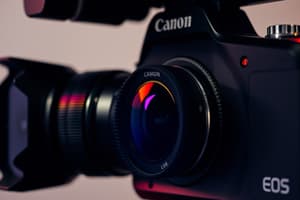Podcast
Questions and Answers
What are the Five Foundational Tools of EOS that drive culture forward?
What are the Five Foundational Tools of EOS that drive culture forward?
The Five Foundational Tools are the Vision/Traction Organizer, Accountability Chart, Rocks, Meeting Pulse, and Scorecard.
How does the Vision/Traction Organizer (V/TO) contribute to decision-making in a company?
How does the Vision/Traction Organizer (V/TO) contribute to decision-making in a company?
The V/TO aligns the team on the vision and provides objective standards for decisions about the Greater Good.
What role does the Accountability Chart play in forming an intentional culture?
What role does the Accountability Chart play in forming an intentional culture?
The Accountability Chart provides clarity on expectations for each person and establishes structure within the organization.
Why are Rocks important in the context of an intentional culture?
Why are Rocks important in the context of an intentional culture?
In what way should the Accountability Chart be treated as a document?
In what way should the Accountability Chart be treated as a document?
What is the significance of having a complete V/TO for the Leadership Team?
What is the significance of having a complete V/TO for the Leadership Team?
How many Rocks should each person focus on at a time, and for what duration?
How many Rocks should each person focus on at a time, and for what duration?
What impact does using the Five Foundational Tools have on a company's trajectory?
What impact does using the Five Foundational Tools have on a company's trajectory?
What is the primary benefit of practicing empathy during conversations?
What is the primary benefit of practicing empathy during conversations?
Why are open-ended questions important in a conversation?
Why are open-ended questions important in a conversation?
How does authenticity affect trust during conversations?
How does authenticity affect trust during conversations?
What should you do if someone shares personal information with you?
What should you do if someone shares personal information with you?
Why is the environment of a meeting important for open discussions?
Why is the environment of a meeting important for open discussions?
What is a key recommendation for discussing performance issues in a Quarterly Conversation?
What is a key recommendation for discussing performance issues in a Quarterly Conversation?
How can clear communication benefit team members during evaluations?
How can clear communication benefit team members during evaluations?
What is the significance of the phrase 'Clear is kind. Unclear is unkind' in feedback conversations?
What is the significance of the phrase 'Clear is kind. Unclear is unkind' in feedback conversations?
What does the acronym REDUCE represent in Jonah Berger's framework for managing change?
What does the acronym REDUCE represent in Jonah Berger's framework for managing change?
How can businesses mitigate reactance during the change process?
How can businesses mitigate reactance during the change process?
Why is it important to address endowment when implementing change?
Why is it important to address endowment when implementing change?
What steps can be taken to overcome the barrier of distance in the change process?
What steps can be taken to overcome the barrier of distance in the change process?
How can uncertainty be alleviated during organizational changes?
How can uncertainty be alleviated during organizational changes?
What role does corroborating evidence play in the change management process?
What role does corroborating evidence play in the change management process?
What practice do companies like EOS Worldwide use to highlight their Core Values?
What practice do companies like EOS Worldwide use to highlight their Core Values?
Why is it necessary for teams to regularly review the tools and concepts discussed in change management?
Why is it necessary for teams to regularly review the tools and concepts discussed in change management?
What is the primary focus of leadership compared to management?
What is the primary focus of leadership compared to management?
How can a State of the Company address benefit the culture within an organization?
How can a State of the Company address benefit the culture within an organization?
Why is it important for the Leadership Team to be unified during the State of the Company address?
Why is it important for the Leadership Team to be unified during the State of the Company address?
What should you ensure when delivering your vision during the State of the Company?
What should you ensure when delivering your vision during the State of the Company?
What is the risk of holding back on communicating your full vision?
What is the risk of holding back on communicating your full vision?
How should the vision be communicated during the address?
How should the vision be communicated during the address?
What document can guide the delivery of the State of the Company address?
What document can guide the delivery of the State of the Company address?
What is the outcome of having an intentional culture within an organization?
What is the outcome of having an intentional culture within an organization?
What does the '5-5-5' framework consist of?
What does the '5-5-5' framework consist of?
How can leaders effectively use the 5-5-5 framework in quarterly conversations?
How can leaders effectively use the 5-5-5 framework in quarterly conversations?
Why is it important for direct reports to approach quarterly conversations as a two-way street?
Why is it important for direct reports to approach quarterly conversations as a two-way street?
What role does active listening play during quarterly conversations?
What role does active listening play during quarterly conversations?
What can be the consequence of not paying enough attention to the 5-5-5 details during quarterly conversations?
What can be the consequence of not paying enough attention to the 5-5-5 details during quarterly conversations?
What is the primary goal of a quarterly conversation between a manager and a direct report?
What is the primary goal of a quarterly conversation between a manager and a direct report?
What kinds of questions can encourage individuals to open up about their strengths?
What kinds of questions can encourage individuals to open up about their strengths?
Why should meetings be scheduled outside the office for quarterly conversations?
Why should meetings be scheduled outside the office for quarterly conversations?
What role do the right tools play in creating an intentional culture?
What role do the right tools play in creating an intentional culture?
How can leaders ensure they are making correct decisions about people in their organization?
How can leaders ensure they are making correct decisions about people in their organization?
Why might business initiatives fail according to the chapter?
Why might business initiatives fail according to the chapter?
What is a metaphor used in the chapter to describe the process of building culture?
What is a metaphor used in the chapter to describe the process of building culture?
What is suggested to do when encountering a rough patch in building culture?
What is suggested to do when encountering a rough patch in building culture?
How does the EOS Process help organizations according to the chapter?
How does the EOS Process help organizations according to the chapter?
What is meant by the term 'People Component' in the context of this chapter?
What is meant by the term 'People Component' in the context of this chapter?
According to the chapter, what might be an outcome of failing to implement key tools?
According to the chapter, what might be an outcome of failing to implement key tools?
Flashcards
Importance of the right tools
Importance of the right tools
Using the right tools and strategies is crucial for building a strong culture. The right tool for each situation can help you build consistent action and follow-up, turning vision into reality.
What is Traction?
What is Traction?
The term Traction refers to the consistent behaviors and habits that turn a vision into reality. It's achieved by using the right tools and strategies to create a strong, intentional culture.
What are EOS tools?
What are EOS tools?
EOS tools are a set of organized and structured methods that help you create an intentional culture. They provide a framework for consistent actions and follow-up, leading to stronger results.
Why are objective tools important?
Why are objective tools important?
Signup and view all the flashcards
What is the EOS Process?
What is the EOS Process?
Signup and view all the flashcards
Chapter focus - Quick Guide
Chapter focus - Quick Guide
Signup and view all the flashcards
EOS Process for Core Values
EOS Process for Core Values
Signup and view all the flashcards
EOS tools for cultural challenges
EOS tools for cultural challenges
Signup and view all the flashcards
What is the purpose of the 5-5-5 method?
What is the purpose of the 5-5-5 method?
Signup and view all the flashcards
What are the three key touch points in the 5-5-5 method?
What are the three key touch points in the 5-5-5 method?
Signup and view all the flashcards
Describe the nature of effective Quarterly Conversations using the 5-5-5 method.
Describe the nature of effective Quarterly Conversations using the 5-5-5 method.
Signup and view all the flashcards
What are the benefits of using the 5-5-5 method in Quarterly Conversations?
What are the benefits of using the 5-5-5 method in Quarterly Conversations?
Signup and view all the flashcards
What is the importance of active listening during Quarterly Conversations?
What is the importance of active listening during Quarterly Conversations?
Signup and view all the flashcards
What are Rocks in the context of the 5-5-5 method?
What are Rocks in the context of the 5-5-5 method?
Signup and view all the flashcards
What are Core Values in the context of the 5-5-5 method?
What are Core Values in the context of the 5-5-5 method?
Signup and view all the flashcards
What are Roles in the context of the 5-5-5 method?
What are Roles in the context of the 5-5-5 method?
Signup and view all the flashcards
What is the V/TO?
What is the V/TO?
Signup and view all the flashcards
How does the V/TO connect to an intentional culture?
How does the V/TO connect to an intentional culture?
Signup and view all the flashcards
What is the Accountability Chart?
What is the Accountability Chart?
Signup and view all the flashcards
How does the Accountability Chart connect to an intentional culture?
How does the Accountability Chart connect to an intentional culture?
Signup and view all the flashcards
What are Rocks?
What are Rocks?
Signup and view all the flashcards
How do Rocks connect to an intentional culture?
How do Rocks connect to an intentional culture?
Signup and view all the flashcards
What is the Meeting Pulse?
What is the Meeting Pulse?
Signup and view all the flashcards
How does the Meeting Pulse connect to an intentional culture?
How does the Meeting Pulse connect to an intentional culture?
Signup and view all the flashcards
Empathy in communication
Empathy in communication
Signup and view all the flashcards
Open-ended questions
Open-ended questions
Signup and view all the flashcards
Being genuine
Being genuine
Signup and view all the flashcards
Maintaining confidentiality
Maintaining confidentiality
Signup and view all the flashcards
Quarterly conversations
Quarterly conversations
Signup and view all the flashcards
Quarterly Conversation's purpose
Quarterly Conversation's purpose
Signup and view all the flashcards
Clarity in communication
Clarity in communication
Signup and view all the flashcards
Specificity as a form of love
Specificity as a form of love
Signup and view all the flashcards
Reactance
Reactance
Signup and view all the flashcards
Endowment
Endowment
Signup and view all the flashcards
Distance
Distance
Signup and view all the flashcards
Uncertainty
Uncertainty
Signup and view all the flashcards
Corroborating Evidence
Corroborating Evidence
Signup and view all the flashcards
REDUCE Framework
REDUCE Framework
Signup and view all the flashcards
Intentional Culture
Intentional Culture
Signup and view all the flashcards
Core Values Callouts
Core Values Callouts
Signup and view all the flashcards
Leadership: Working 'on' the business
Leadership: Working 'on' the business
Signup and view all the flashcards
Management: Working 'in' the business
Management: Working 'in' the business
Signup and view all the flashcards
State of the Company Address
State of the Company Address
Signup and view all the flashcards
Vision/Traction Organizer (V/TO)
Vision/Traction Organizer (V/TO)
Signup and view all the flashcards
Leadership Team Alignment
Leadership Team Alignment
Signup and view all the flashcards
Compelling Vision
Compelling Vision
Signup and view all the flashcards
Vision's Impact on Individuals
Vision's Impact on Individuals
Signup and view all the flashcards
Effective Communication of the Vision
Effective Communication of the Vision
Signup and view all the flashcards
Study Notes
Chapter 6: Proven Tools and Strategies to Build an Intentional Culture
- Culture retraining involves using the language of core values
- Effective business initiatives require consistent action and follow-up
- EOS tools (e.g., Vision/Traction Organizer, Accountability Chart, Rocks) are crucial for intentional culture building
- "20 percent" of EOS tools produce "80 percent" of the desired results
- Tools to quickly build culture include the Vision/Traction Organizer, Accountability Chart, and Rocks
- Frequent use of the tools helps to improve cultural consistency, ensure alignment, and make changes effective
Chapter 7: The Key EOS Tools for Building an Intentional Culture
- EOS has twenty tools, but the five foundational tools are the most impactful
- The Vision/Traction Organizer (V/TO) is essential for documenting the vision and plan.
- The Accountability Chart clarifies expectations and responsibilities for each team member
- Rocks are the three to seven biggest prioritized tasks needed to maintain focus for quarterly periods
- Level 10 Meetings help ensure accountability across the organization by reviewing priorities and to-do lists.
Chapter 8: The Crucial Role of Hiring
- Poor hiring practices lead to the same problems over and over. Turnover is a painful part of change
- Companies need to ensure that new hires align with the company's core values.
- Hiring slow and using a structured interview process (behavioral questions, etc.) help avoid mismatches
- The importance of clearly outlining company expectations and values to avoid future issues
Chapter 9: Onboarding
- Onboarding is equally important as the hiring process
- It is essential to communicate clearly core values, roles, and company expectations in onboarding
- Using checklists and a timeframe help new hires understand the organization
- New hires need to be shown that the team cares about their success and the organization is structured
Reflection Questions
- Students are encouraged to reflect on their company's hiring and onboarding practices.
Studying That Suits You
Use AI to generate personalized quizzes and flashcards to suit your learning preferences.


